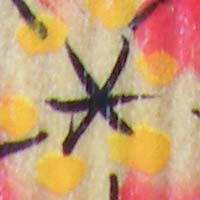Fujifilm FinePix S8100fd Review
Review Date: August 1st 2008
Author: Gavin Stoker
Leave a comment about this Review
|
Image Quality
All of the sample images in this Review were taken using the 10M (3648 x 2736) JPEG image size option., which gives an average image size of around 5Mb.
Though a reasonable level of detail and depth of field is generally captured by the Fujifilm FinePix S8100fd, there is some loss of sharpness towards the edges of the frame, most noticeable at maximum wide-angle setting, while highlight detail tends to suffer in bright sunshine. There's softness too at maximum telephoto, though this is slightly more to be expected, and can of course be given a helping hand courtesy of unsharp mask in Photoshop.
More positively, in general use colours really zing, especially if switching to chrome colour effect mode, which gives everything an added richness in the style of a 1950s colour postcard or Martin Parr perhaps, without making the picture appear too overtly tinkered with. Purple fringing too is largely absent between areas of high contrast.
As we expected, image noise is well controlled up to ISO 800, becoming readily apparent at ISO 1600. From then on in you're losing noise but successively detail with it at ISO 3200 and ISO 6400, the latter looking more like a stills 'grab' from a video camera feed. White balance did however vary between our test shots, both in our ISO examples and when photographing the white wall, suggesting manual adjustment is the way forward if it's important to you consistency is maintained.
Still, this camera is really all about that 18x optical zoom range being perfect for just about every scenario – and particularly candids – meaning that we can live with the odd 'mistake' when more often than not you're onto a winner.
Noise
There are 8 ISO settings available on the Fujifilm FinePix S8100fd. Noise is well controlled up to ISO 800, becoming readily apparent at ISO 1600. From then on in you're losing noise but successively detail with it at ISO 3200 and ISO 6400, the latter looking more like a stills 'grab' from a video camera feed. Here are some 100% crops which show the noise levels for each ISO setting:
ISO 64 (100% Crop) |
ISO 100 (100% Crop) |
 |
 |
ISO 200 (100% Crop) |
ISO 400 (100% Crop) |
 |
 |
ISO 800 (100% Crop) |
ISO 1600 (100% Crop) |
 |
 |
ISO 3200 (100% Crop) |
ISO 6400 (100% Crop) |
 |
 |
Sharpening
Here are two 100% crops which have been Saved as Web - Quality 50 in Photoshop. The right-hand image has had some sharpening applied in Photoshop. The out-of-the camera images are perfectly fine at the default sharpening setting, and don't really benefit from any further sharpening in a program like Adobe Photoshop. You can also change the in-camera sharpening level.
Original
(100% Crop) |
Sharpened (100% Crop) |
 |
 |
 |
 |
Chromatic Aberrations
The Fujifilm FinePix S8100fd dealt well with chromatic aberrations during the review, with limited purple and cyan fringing present around the edges of objects in certain high-contrast situations, especially at the telephoto end of the 18x zoom.
Chromatic
Aberrations
1 (100% Crop) |
Chromatic
Aberrations
2 (100% Crop) |
 |
 |
Macro
The Fujifilm FinePix S8100fd offers a Super-Macro setting that allows you to focus on a subject that is just 1cm away from the camera when the lens is set to wide-angle. The first image shows how close you can get to the subject (in this case a compact flash card). The second image is a 100% crop.
Macro |
Macro (100% Crop) |
 |
 |
Flash
The flash settings on the Fujifilm FinePix S8100fd are Auto, Forced Flash, Slow Synchro, Red-eye Reduction Auto, Red-eye Reduction & Forced Flash. These shots of a white coloured wall were taken at a distance of 1.5m.
Flash Off - Wide Angle (27mm) |
Auto Flash - Wide Angle (27mm) |
 |
 |
Flash Off - Telephoto (486mm) |
Auto Flash - Telephoto (486mm) |
 |
 |
And here are some portrait shots. As you can see, both the Forced Flash and Red-Eye Reduction options caused a very small amount of red-eye.
Forced Flash |
Forced Flash (100% Crop) |
 |
 |
Red-Eye Reduction |
Red-Eye Reduction (100% Crop) |
 |
 |
Night Shot
The Fujifilm FinePix S8100fd maximum shutter speed is 30 seconds, which is good news if you're seriously interested in night photography. The shot below was taken using a shutter speed of 1.9 seconds at ISO 400. I've included a 100% crop of the image to show what the quality is like.
Night Shot |
Night Shot (100% Crop) |
 |
 |
|
![]() PhotographyBLOG
is a member of the DIWA
organisation. Our test results for the Fujifilm FinePix S8100fd have
been submitted to DIWA
for comparison with test results for different samples of
the same camera model supplied by other DIWA
member sites.
PhotographyBLOG
is a member of the DIWA
organisation. Our test results for the Fujifilm FinePix S8100fd have
been submitted to DIWA
for comparison with test results for different samples of
the same camera model supplied by other DIWA
member sites.
